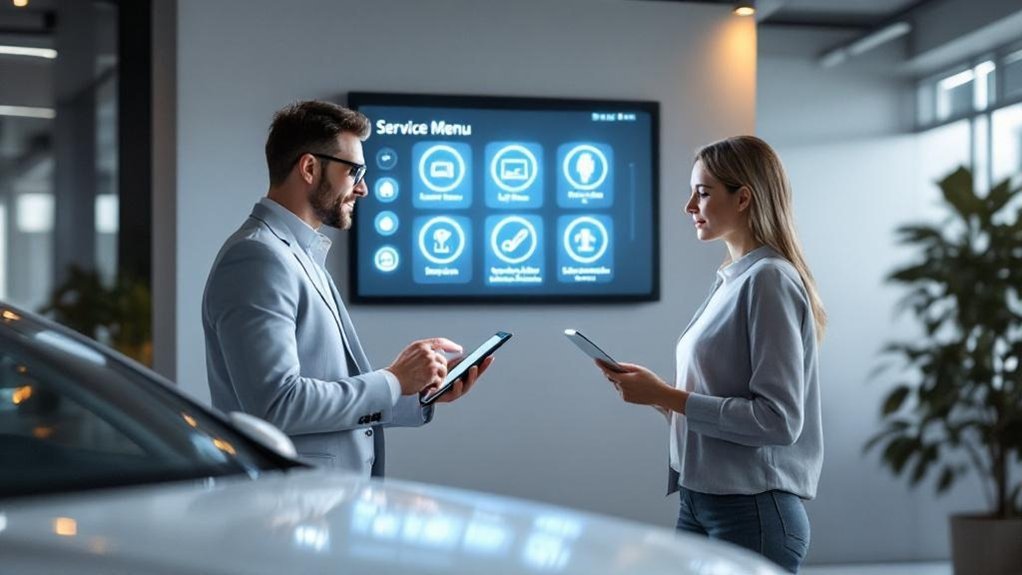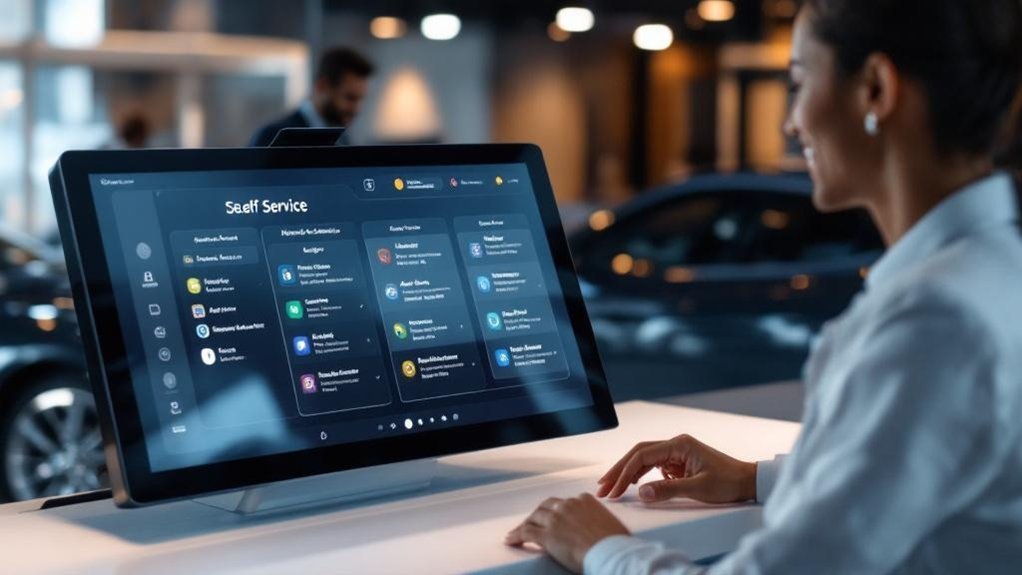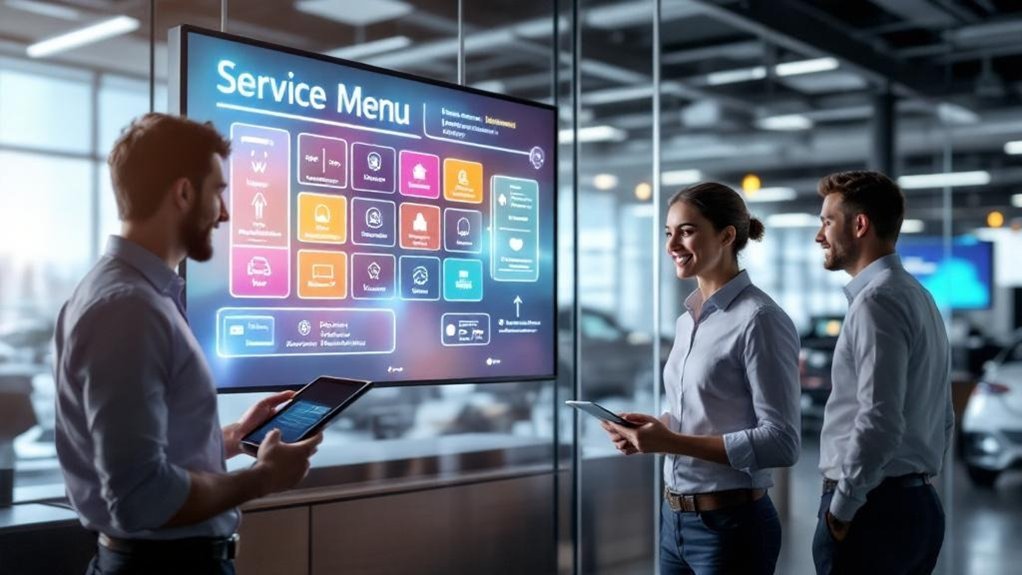You’ll automate personalized upsells by presenting clear, itemized service bundles tied to vehicle history and real-time pricing, which drives conversion and lifts service revenue by about 30%. Customers get contextual recommendations and interactive add-ons online, so advisors spend roughly 20% less time on routine explanations and more on complex diagnostics. Integrated menus sync with your DMS and POS for instant estimates, status updates, and payments — keep going to see practical features, KPIs, and an implementation roadmap.
Key Takeaways
- Digital service menus present personalized, itemized service bundles based on vehicle history, enabling automated, relevant upsell offers.
- Interactive prompts let customers add guided add-ons online, increasing upsell conversion while reducing advisor explanations.
- Real-time pricing and inventory integration ensures accurate upsell offers without manual advisor verification.
- Automated status updates, reminders, and pre-visit confirmations shift routine communication from advisors to the platform.
- Conversion analytics and A/B testing identify top-performing upsells, refining offers and minimizing advisor intervention.
Key Takeaways for Dealers and Customers

1 clear benefit of digital service menus is that they turn service interactions into measurable revenue opportunities by using vehicle history and customer preferences to automate upsells—driving about a 30% lift—while real‑time inventory and pricing keep offers accurate and trustworthy. You’ll see reduced advisor talk time (about 20%) because decisions are streamlined, letting staff focus on higher‑value conversations. Personalized maintenance reminders boost repeat visits and raise average transaction value roughly 25%, so your customer engagement becomes both proactive and profitable. Use analytics dashboards to track which upsell strategies work and iterate quickly to achieve ROI within 6–12 months. The result: better customer experiences, clearer performance metrics, and a scalable approach to service lane revenue.
How Digital Service Menus Work in the Service Lane
You’ll get real-time visibility into available services and pricing so customers can see exactly what’s recommended and why, which speeds approvals and reduces advisor talk time. Interactive upsell selection lets customers customize packages and immediately view cost and warranty impacts, boosting acceptance rates through transparent choices. Together, these features make the service lane more efficient and measurable, improving satisfaction and increasing per-visit revenue.
Real-Time Service Visibility
When service lanes integrate digital service menus with your dealership management system, customers get real-time visibility into repairs, pricing, promotions and service history straight to their phones, which boosts transparency and cuts routine advisor communication. You’ll deliver measurable service transparency and stronger customer engagement by pushing automated status updates, accurate estimates and maintenance records to owners without a call. That reduces advisor talk time for routine check-ins and shifts their role toward consultative, revenue-driving conversations. Live pricing and promotions let customers make swift, informed choices, while immediate access to service history encourages proactive maintenance. Operational efficiency improves as fewer administrative explanations are needed, appointment throughput rises, and advisors focus on complex diagnostics and customer satisfaction metrics rather than repetitive updates.
Interactive Upsell Selection
Because customers want quick, transparent choices, interactive upsell selection turns your digital service menu into a revenue engine by presenting clear, itemized options tailored to each vehicle’s history and owner preferences. You’ll let customers customize service packages themselves, using contextual prompts based on vehicle history and customer preferences to surface relevant offers. That data-driven approach boosts average transaction value by roughly 25% and increases upsell rates about 30% while cutting advisor talk time near 20%. Real-time pricing and promotion updates keep offers accurate and timely, encouraging faster decisions. Strategic upsell strategies use analytics to bundle services, automate recommendations, and trigger personalized reminders—so you improve efficiency, grow revenue, and strengthen loyalty without extra staff time.
Features That Drive Automated Upsells

You’ll boost acceptance by presenting tailored service bundles that match a vehicle’s history and each customer’s preferences, so offers feel relevant rather than generic. Pairing those bundles with real-time inventory and pricing updates keeps upsell options accurate and immediately actionable. Use conversion analytics to continually refine which bundles and in-stock offers drive the best results.
Tailored Service Bundles
One smart bundle can turn a routine service visit into a tailored upsell opportunity by using vehicle history and customer preferences to recommend context-sensitive add-ons that feel relevant, not pushy. You’ll boost customer engagement and service personalization by presenting bundles that match past repairs, mileage, and owner choices. Interactive customization lets customers add or tweak items and see instant cost/benefit feedback, so decisions happen faster and feel collaborative. Targeted promotions and alerts push timely offers to devices, increasing conversion odds. Back-end analytics track which bundles convert, so you can refine offerings and measure ROI. By combining data-driven recommendations, easy customization, and targeted outreach, you reduce advisor talk time while increasing service attach rates.
Real-time Inventory Offers
Real-time inventory offers tie your parts and service catalog directly into the customer journey so upsells are accurate, timely, and fulfillable — not just suggested. You’ll use real time offers driven by inventory management to present only available parts and services, cutting delays and false promises. By analyzing vehicle history and customer preferences, the system generates context-sensitive bundles that actually resonate. Interactive customization controls let customers add services and see cost impacts instantly, increasing conversion confidence. Targeted promotions and service status updates push timely add-ons to devices, nudging behavior without advisor intervention. Dashboards track conversion rates and preferences, giving you data to refine tactics, optimize stock levels, and continuously improve automated upsell performance and operational efficiency.
Streamlined Appointment Intake and Pre-Visit Engagement
When customers can pick services and options online before they arrive, your dealership cuts through back-and-forth phone calls and shortens advisor talk time by roughly 20%. You’ll streamline appointment intake by letting customers select itemized services, see real-time pricing, and choose appointment flexibility that fits their schedule. Using vehicle history and customer preferences, digital menus present tailored recommendations that educate buyers pre-visit and reduce indecision at drop-off. Interactive pre-visit engagement — confirmations, upgrade prompts, and transparent bundles — speeds check-in and raises conversion rates without extra advisor labor. Integrating inventory and pricing guarantees offers are accurate and actionable, so upsells happen during scheduling rather than over the phone. The result: higher customer satisfaction, fewer callbacks, and measurable operational efficiency gains.
Guided Self-Service Upsells and Interactive Bundles

You’ll boost conversions by offering interactive bundle selection that shows real-time pricing and immediate value so customers can compare options quickly. Guided add-on prompts, tailored to vehicle history and preferences, raise upsell rates while cutting advisor talk time. Use analytics to track which bundles convert best and iterate offers to lift average transaction value.
Interactive Bundle Selection
While you configure service options, interactive bundle selection lets customers build tailored packages that boost upsells by about 30% through personalized recommendations tied to vehicle history and preferences. You’ll reduce advisor talk time roughly 20% as customers self-serve, freeing staff for higher-value work. Real-time inventory and pricing strategies guarantee offers are accurate, increasing conversion velocity and trust. Interactive controls show immediate cost and benefit impacts, improving customer engagement and informed decisions. Dashboards give you the data to iterate bundles based on uptake and preferences, optimizing revenue per visit.
- Empower customers to combine services that reflect maintenance history and predicted needs.
- Use live pricing strategies to present relevant, in-stock options that convert.
- Track bundle performance to refine offers and lift overall throughput.
Guided Add-On Prompts
How do guided add-on prompts turn routine bookings into higher-value visits? You’ll present relevant upsell options based on vehicle history and preferences, improving customer experience while driving revenue. Guided self-service upsells let customers add services with confidence: interactive bundles show real-time cost impacts as they toggle options, so decision-making is faster and clearer. Integration with live inventory and pricing guarantees offers are accurate and immediately actionable, streamlining approvals. The result? Advisors spend about 20% less time on routine pitches, freeing them for complex consultations. Use analytics dashboards to track conversion rates and refine upsell strategies—data shows average transaction value can rise up to 25%. This approach balances convenience, transparency, and measurable financial lift.
Reducing Advisor Talk Time While Preserving Service Quality
Because customers can see clear, itemized options and make choices on their own, digital service menus cut average advisor talk time by about 20% while keeping quality intact. You’ll boost advisor efficiency by shifting routine explanations to the interface, letting advisors focus on diagnostics and complex recommendations. Real-time updates and integrated payments speed transactions, and interactive customization means customers tailor packages without heavy advisor input. Analytics drive targeted offers based on vehicle history, automating upsells while preserving service satisfaction.
- Empower customers with transparent choices to reduce back-and-forth and increase trust.
- Use tailored bundles to present relevant upsells without manual pitching.
- Monitor dashboards to refine prompts, improving conversion rates and quality outcomes.
Integration Best Practices With DMS and POS Systems

When your digital service menu talks directly to your DMS and POS, you get context-aware recommendations, instant pricing and inventory checks, and seamless payments that cut friction and lift revenue. You should tackle integration challenges by mapping data fields, enforcing security protocols, and validating real-time vehicle histories so upsells match customer needs. Follow best practices: build APIs for two-way sync, reconcile pricing and inventory continuously, and enable atomic transactions to avoid payment errors. Automate offers based on service history and customer preferences to raise average ticket size while trimming advisor talk time. Train staff on exception workflows and monitor system health. That data-driven, customer-focused approach reduces friction, preserves trust, and makes upsells timely and accurate.
Measuring Success: KPIs, Analytics, and ROI
Any modern digital service menu needs clear KPIs and analytics tied to business outcomes so you can track whether upsells, advisor efficiency, and transaction values are actually improving. You’ll set KPI benchmarks — target a 30% upsell increase, ~20% advisor talk-time reduction, and ~25% higher average transaction value — and use analytics tools for real-time segmentation and promotion performance. Run weekly dashboard checks and A/B tests to capture conversion lifts, model incremental revenue per visit, and estimate shifts in customer lifetime value. Expect ROI in 6–12 months if you close feedback loops and standardize operations.
- Monitor conversion rate lift, average transaction uplift, and advisor time-on-call.
- Use real-time dashboards for targeted upsell tactics.
- Model incremental revenue and LTV changes.
Local SEO and Digital Menus: Driving Foot Traffic and Conversions

While optimizing your digital service menu for local search, you’ll turn online visibility into measurable foot traffic and higher conversion rates by aligning menu content, real-time availability, and targeted promotions with nearby search intent. You’ll attract nearby customers actively seeking services by structuring service pages with location signals, relevant keywords, and schema so search engines surface your offers first. Use vehicle history and preference data to automate timely upsells within the menu, increasing conversions without extra advisor time. Real-time updates and payments streamline visits, lifting throughput and satisfaction. Deploy targeted promotions to capture local search intent and measure which offers drive in-store visits. Analyze menu analytics to refine demographics, optimize customer engagement, and prioritize high-impact SEO tweaks for continuous growth.
Implementation Roadmap and Change Management Strategies
Because a successful rollout hinges on both process design and people adoption, start by mapping your current service workflow to pinpoint where automation can cut advisor talk time by about 20% and lift transaction value by up to 25%. You’ll phase the rollout: pilot, measure, refine, then scale. Address implementation challenges proactively with clear KPIs, analytics dashboards, and regular feedback loops so you can adjust upsell flows in real time. Training strategies must be hands-on, role-based, and tied to ROI metrics to drive adoption and a culture of adaptability. Expect measurable ROI within 6–12 months when pilots validate gains and staff embrace the change.
- Pilot in targeted departments to gather upsell and efficiency data
- Use dashboards to monitor KPIs and quicken iterations
- Run focused, role-specific training sessions
Frequently Asked Questions
How to Increase Sales in a Car Dealership?
You’ll boost sales by deploying targeted sales strategies and improving customer engagement: use data-driven digital menus, personalize offers, automate upsells, track KPIs, train advisors on consultative selling, and optimize real-time pricing to lift ARO and loyalty.
Why Is It Essential to Focus on Local SEO in Digital Marketing for Car Dealerships?
76% of nearby searchers visit within a day, so you’ll prioritize local search to boost foot traffic and conversions; strengthening your digital presence drives targeted, data-driven visits, increases loyalty, and converts mobile interest into sales.
Which Inventory Method Would a Car Dealership Use for Tracking the Purchase of a Used Car and Why?
You’d use the specific identification method, not FIFO method or LIFO method, because it gives precise cost tracking per vehicle, letting you make data-driven pricing, optimize turnover, and deliver customer-focused profitability insights.
Conclusion
Digital service menus let you boost revenue while cutting advisor talk time by automating relevant upsells and guiding customers with data-driven bundles. You’ll see faster intake, higher conversion rates, and clearer KPIs — and yes, it won’t alienate customers: personalized, transparent options increase trust and uptake when done right. Start with DMS/POS integration, track lift and ROI, and iterate on messaging so every interaction becomes a measurable growth opportunity.
